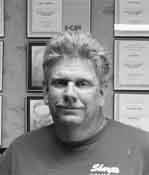 | Richard Smith has been in the Auto Body Industry for 26 years. He is ASE Certified Master Collision Tech, an I-Car Platinum Tech, and an I-Car Instructor. He and His wife own and operate Sharp's Auto Body & Collision Inc. located at 202 North Elm St. in Pittsburg, Kansas. He is a father of 5 children, Ex Military E-6 Staff SGT. and is active in his home Church. The one thing he enjoys doing is educating the public about the safety and proper repair of automobiles, no matter if it is a vehicle that has been in a collision, a small dent, or a complete restoration. The shop is always equipped with a skilled professional to handle your auto needs. |
Automotive Service & Repair
2012-11-09 08:21:24
What is waterborne paint?
A- Last month we discussed how waterborne paint for vehicles will soon become the "norm" in as a base paint in the auto industry. It is also our way of "Going green" in the auto body business. This month we dive into a more detailed description of waterborne paints.
While solvent based paints are still legal to spray in most parts of the country, there are certain states and counties that mandate waterborne paint only, and the trend is increasing. As environmental regulations become stricter, many shops are looking at waterborne paint systems to help their body shops go green.
So what is waterborne paint, and how does it work? Waterborne paint is exactly what the name implies. Solvent-based paints use solvent to suspend the paint pigments and deliver them to the surface to be covered, while waterborne paints use water.
Waterborne paint reduces the emission of volatile organic compounds (VOCs), improving air quality and reducing the health risk to all involved. For compliance in the restricted areas, the limit is a VOC of 3.5 ppm for basecoats and 2.1 for primers and clears.
Waterborne paint has become the standard, as 70 percent of all OEM vehicles are now painted with this material. It has been the standard in Europe for quite some time, so while the latest waterborne paints are new technology, the concept is neither new nor experimental. In many cases, however, solvent-based paints can be altered to achieve compliance through the addition of other chemicals such as KV1, which is added to solvent-based paints to lower the VOC.
But converting to waterborne isn’t as simple as switching out paint cans. Spraybooths, spray guns and gun cleaning equipment often must be updated. Paint prep and application steps must be adjusted, along with cycle time expectations. Converting to waterborne takes the patience and commitment of shop owners, managers, and painters. We believe it is worth all the effort.


